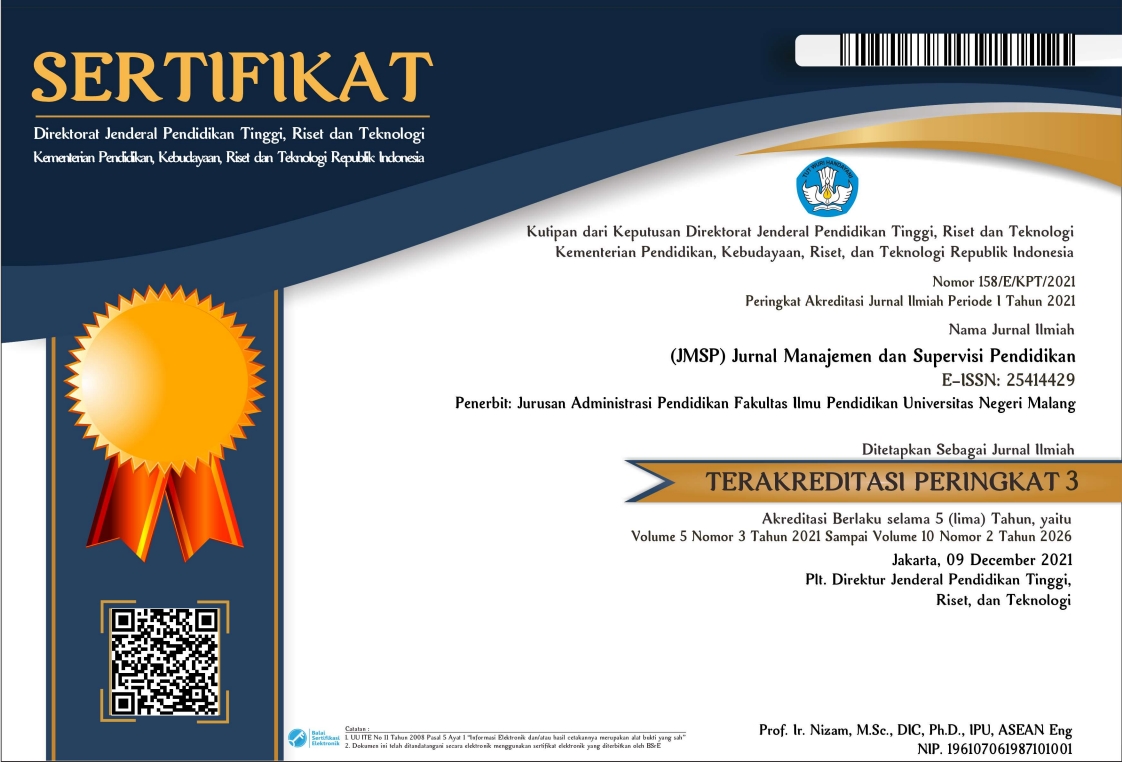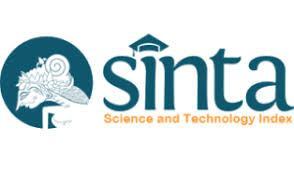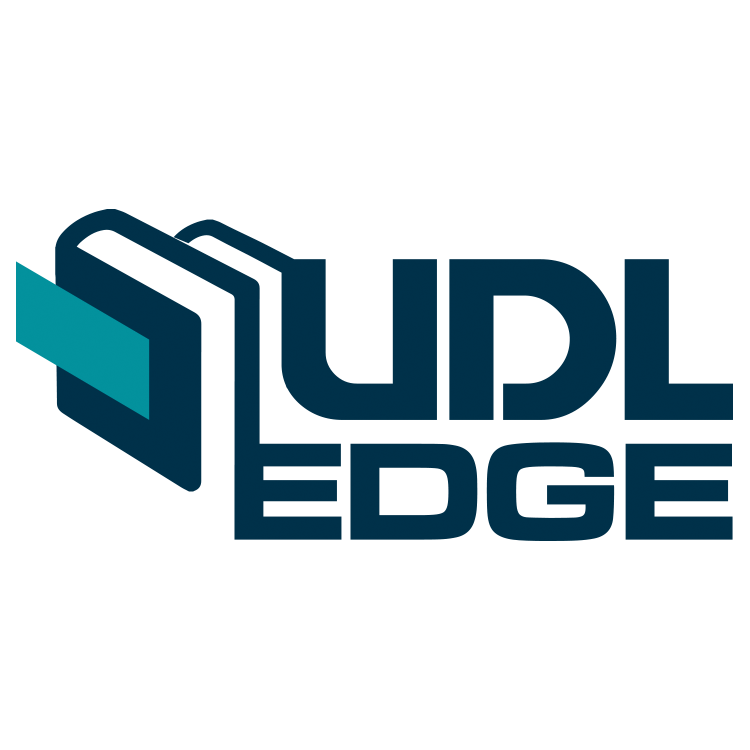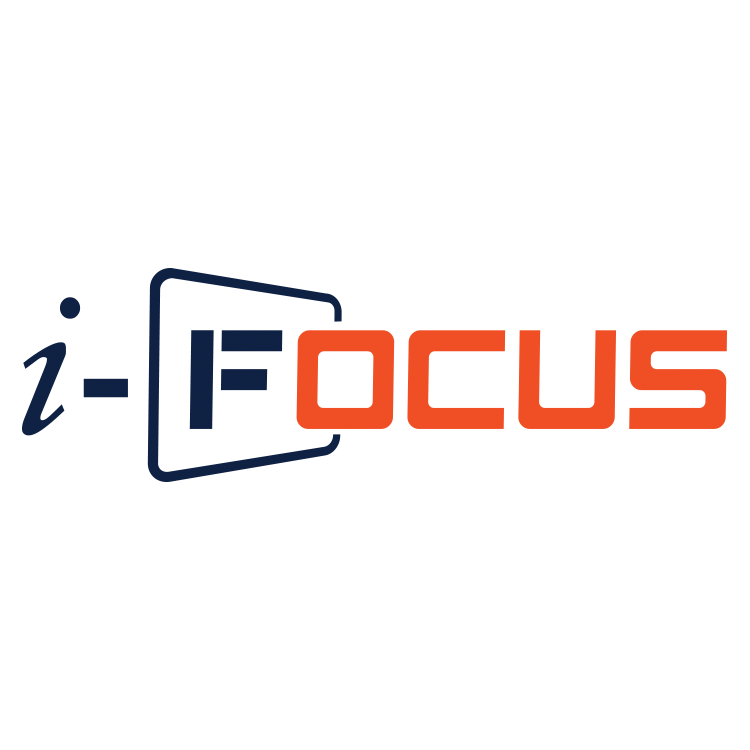Management of Blended Learning and Learning Motivation and Student Learning Achievement
Abstract
Keywords
Full Text:
PDFReferences
Abidah, A., Hidaayatullaah, H. N., Simamora, R. M., Fehabutar, D., & Mutakinati, L. 2020. The Impact of Covid-19 to Indonesian Education and its Relation to the Philosophy of “Merdeka Belajar”. Studies in Philosophy of Science and Education, 1(1), 38-49. Dari https://sciejournal.com/index.php/SiPoSE/article/view/9.
Aliati, F. 2022. Kesenjangan Teknologi Pendidikan di Indonesia pada Masa Pandemi, (Online) , (https://kumparan.com/fififidyah8/kesenjangan-teknologi-pendidikan-di-indonesia-pada-masa-pandemi-1zIogMuzILz), diakses 10 Februari 2023.
Anderson, T. 2008. The Theory and Practice of Online Learning. Athabasca: Athabasca University.
Astuti, A., & Leonard, L. 2015. Peran Kemampuan Komunikasi Matematika terhadap Prestasi Belajar Matematika Siswa. Formatif: Jurnal Ilmiah Pendidikan MIPA, 2(2). Dari https://journal.lppmunindra.ac.id/index.php/Formatif/article/view/91.
Bibi, S., & Jati, H. 2015. Efektivitas Model Blended Learning terhadap Motivasi dan Tingkat Pemahaman Mahasiswa Mata Kuliah Algoritma Dan Pemrograman. Jurnal pendidikan vokasi, 5(1), 74-87. Dari https://journal.uny.ac.id/index.php/jpv/article/view/6074.
Chang, C. C., Shu, K. M., Liang, C., Tseng, J. S., & Hsu, Y. S. 2014. Is Blended E-Learning as Measured By an Achievement Test and Self-Assessment Better Than Traditional Classroom Learning for Vocational High School Students?. International Review of Research in Open and Distributed Learning, 15(2), 213-231. Dari hhttps://www.erudit.org/en/journals/irrodl/1900-v1-n1irrodl04928/1065293ar/abstract/.
Cucinotta, D. & Vanelli, M. 2020. WHO Declares COVID-19 a Pandemic. Acta Biomedica, 91(1), pp. 157–160. doi: 10.23750/abm.v91i1.9397. Dari https://www.ncbi.nlm.nih.gov/pmc/articles/PMC7569573/.
Daffa, I. N. 2021. Jelang Perkuliahan Secara Blended Learning, Wakil Rektor II Tinjau Gedung Kuliah Bersama, (Online), dari https://um.ac.id/berita/jelang-perkuliahan-secara-blended-learning-wakil-rektor-ii-tinjaugedung-kuliah-bersama/, diakses 27 November 2021.
Deignan, S. 2021. Hybrid Learning vs Blended Learning. What Is The Difference?. (Online), dari https://www.mentimeter.com/blog/interactive-classrooms/hybrid-learning-vs-blended-learning-what-is-the-difference, diakses 14 Maret 2022.
Direktorat Pendidikan Agama Islam. 2020. Sebanyak 70% Siswa Sulit Memahami Materi Selama Pembelajaran Daring, (Online), (http://www.pendis.kemenag.go.id/pai/berita-214-sebanyak-70-siswa-sulit-memahami-materi-selama-pembelajaran-daring.html#informasi_judul), diakses 10 Februari 2023.
Djalante, R., Lassa, J., Setiamarga, D., Sudjatma, A., Indrawan, M., Haryanto, B., Mahfud, D., Sinapoy, M.S., Djalante, S. Rafliana, I., Gunawan L. A., Surtiari, G.A.K., & Warsilah, H. 2020. Review and Analysis of Current Responses to COVID-19 in Indonesia: Period of January to March 2020. Progress in Disaster Science, 6,100091. Dari https://www.sciencedirect.com/science/article/pii/S2590061720300284.
Djarwo, C. F. 2020. Analisis Faktor Internal dan Eksternal Terhadap Motivasi Belajar Kimia Siswa SMA Kota Jayapura. Jurnal Ilmiah IKIP Mataram, 7(1), 1-7.
Dziuban, C., Graham, C. R., Moskal, P. D., Norberg, A., & Sicilia, N. 2018. Blended Learning: the New Normal and Emerging Technologies. International Journal of Educational Technology in Higher Education, 15(1), 1-16. Dari https://link.springer.com/article/10.1186/s41239-017-0087-5.
Fadillah, A., Nopitasari, D. & Pradja, B. P. 2020. Blended Learning Model During the Covid-19 Pandemic: Analysis of Student’s’ Mathematical Disposition. JTAM (Jurnal Teori dan Aplikasi Matematika), 4(2), 173-181. Dari http://journal.ummat.ac.id/index.php/jtam.
Ferlazo, L. 2020. Blended Learning in the Age of COVID-19, (Online), (https://www.edweek.org/teaching-learning/opinion-blended-learning-in-the-age-of-covid-19/2020/08, diakses 27 November 2021.
Gagné, F., & St Père, F. 2001. When IQ is Controlled, Does Motivation Still Predict Achievement?. Intelligence, 30(1), 71-100. https://doi.org/10.1016/S0160-2896(01)00068-X.
Güzer, B. & Caner, H. 2014. The Past, Present and Future of Blended Learning: An in Depth Analysis of Literature. Procedia - Social and Behavioral Sciences, 116, pp.4596–4603. doi: 10.1016/j.sbspro.2014.01.992. Dari https://www.sciencedirect.com/science/article/pii/S187704281401009X.
Hamdu, G. & Agustina. L. 2011. Pengaruh Motivasi Belajar Siswa Terhadap Prestasi Belajar IPA di Sekolah Dasar. Jurnal Penelitian Pendidikan, 12(1), 90-96. Dari http://jurnal.upi.edu/file/8-GhullamHamdu.pdf.
Hardika, H., Razak, A. Z. B. A., Soraya, D. U., Aisyah, E. N., Iriyanto, T., & Juharyanto, J. 2021. Analysis of Student Learning Outcomes’ Standards in Lecturers in the Perspective of a Disruptive Era. Cypriot Journal of Educational Sciences, 16(5), 2193-2208.
Kapitan, I. K., Kareri, D. G. R., & Amat, A. L. S. 2021. Hubungan Motivasi Belajar dengan Prestasi Akademik Mahasiswa Fakultas Kedokteran di Nusa Tenggara Timur. Cendana Medical Journal (CMJ), 9(1), 64-71. Dari https://www.researchgate.net/publication/358229830/HUBUNGAN_MOTIVASI_BELAJAR_DENGAN_PRESTASI_AKADEMIK_MAHASISWA_FAKULTAS_KEDOKTERAN_DI_NUSA_TENGGARA_TIMUR.
Kari, M. L., Bare, Y., & Mago, O. Y. T. 2021. Persepsi Mahasiswa Terhadap Pembelajaran Berbasis Blended Learning dengan Memanfaatkan Aplikasi Microsoft Teams. Qalam: Jurnal Ilmu Kependidikan, 10(2), 63-71. Dari http://ejournal.um-sorong.ac.id/index.php/jq/article/view/1418.
Kasih, A. P. 2020. Survei UNICEF: 66 Persen Siswa Mengaku Tak Nyaman Belajar di Rumah, (Online), (https://edukasi.kompas.com/read/2020/06/24/090832371/survei-unicef-66-persen-siswa-mengaku-tak-nyaman-belajar-di-rumah), diakses 10 Februari 2023.
Kazu, I. Y., & Demirkol, M. 2014. Effect of Blended Learning Environment Model on High School Students’ Academic Achievement. Turkish Online Journal of Educational Technology-TOJET, 13(1), 78-87. Dari https://eric.ed.gov/?id=EJ1018177.
Kemendikbud. 2021. Dampak Negatif Satu Tahun PJJ, Dorongan Pembelajaran Tatap Muka Menguat. (Online), (https://www.kemdikbud.go.id/main/blog/2021/04/dampak-negatif-satu-tahun-pjj-dorongan-pembelajaran-tatap-muka-menguat), diakses 27 November 2021.
Lestari, A. K., Arifin, I., & Sunarni, S. 2021. Manajemen Budaya Sekolah dalam Implementasi Penguatan Pendidikan Karakter di Sekolah Berbasis Islam. Jurnal Pendidikan: Teori, Penelitian, dan Pengembangan, 6(12), 1846-1852.
Müller, F. A. and Wulf, T. 2021. Blended Learning Environments that Work: An Evidence-Based Instructional Design for the Delivery of Qualitative Management Modules. International Journal of Management Education, 19(3), p. 100530. doi:10.1016/j.ijme.2021.100530. Dari https://www.sciencedirect.com/
science/article/abs/pii/S1472811721000793.
Ompusunggu, H. E. S. 2020. Hubungan Antara Motivasi Belajar Dengan Prestasi Belajar Mahasiswa/i Fakultas Kedokteran Universitas HKBP Nommensen. Nommensen Journal of Medicine, 6(1), 32-35. Dari https://jurnal.uhn.ac.id/index.php/medicine/article/view/247.
Perdana, N. 2022. 30 Mahasiswa dan Dosen UM Kota Malang Terpapar Covid-19, Perkuliahan Dibatasi, (Online), (https://surabaya.kompas.com/read/2022/02/04//30-mahasiswa-dan-dosen-um-kota-malang-terpapar-covid-19perkuliahan?page=all), diakses 15 Februari 2023.
Petersen, E., Hui, D., Hamer, D. H., Blumberg, L., Madoff, L. C., Pollack, M., Lee, S.S, McLellan, S., Memish, Z., Praharaj, I., Wasserman, S., Ntoumi, F., Azhar, E.I., Mchugh, T.D, Kock, R., Ippolito, G., Zumla, A., & Koopmans, M. 2020. Li Wenliang, a Face to the Frontline Healthcare Worker. The First Doctor to Notify the Emergence of the SARS-CoV-2, (COVID-19) Outbreak. International Journal of Infectious Diseases, 93, 205-207 Dari https://www.ijidonline.com/article/S1201-9712(20)30111-9/fulltext.
Rosail, D. A., & Rohayati, S., 2022. Pengaruh Pembelajaran Blended Learning, Kecerdasan Emosional dan Minat Belajar terhadap Hasil Belajar Komputer Akuntansi SMKN 2 Kota Kediri. Briliant: Jurnal Riset dan Konseptual, 7(2), 324-336. Dari https://jurnal.unublitar.ac.id/index.php/briliant/article/view/965.
Saifulloh, A. M., & Darwis, M. 2020. Manajemen Pembelajaran dalam Meningkatkan Efektivitas Proses Belajar Mengajar di Masa Pandemi Covid-19. Bidayatuna Jurnal Pendidikan Guru Mandrasah Ibtidaiyah, 3(2), 285-312.
Shereen, M. A., Khan, S., Kazmi, A., Bashir, N., & Siddique, R. 2020. COVID-19 Infection: Origin, Transmission, and Characteristics of Human Corona viruses. Journal of Advanced Research, 24, 91. doi: 10.1016/j.jare.2020.03.005. Dari https://pubmed.ncbi.nlm.nih.gov/32257431/.
Sjukur, S. B. 2012. Pengaruh Blended Learning Terhadap Motivasi Belajar dan Hasil Belajar Siswa di Tingkat SMK. Jurnal Pendidikan Vokasi, 2(3), pp. 368–378. doi: 10.21831/jpv.v2i3.1043. Dari https://journal.uny.ac.id/index.php/jpv/article/view/1043.
Sugesti, H., Triputranto, B., & Diawati, P. 2021. Pengaruh Blended Learning dan Minat Belajar Terhadap Hasil Belajar di Masa Pandemi Pada Siswa SMKN 1 GARUT. Pro Mark, 11(2). Dari https://ejurnal.poltekpos.ac.id/index.php/promark/article/view/1922.
Sultoni, S., Gunawan, I., & Pratiwi, F. D. 2018. Perbedaan Motivasi Belajar Mahasiswa Antara Sebelum danSesudah Mengikuti Pelatihan Motivasional. Ilmu Pendidikan: Jurnal Kajian Teori dan Praktik
Kependidikan, 3(1), 115-119. Dari http://journal2.um.ac.id/index.php/jktpk/article/view/4432.
Suprihatin, S. 2015. Upaya Guru dalam Meningkatkan Motivasi Belajar Siswa. Jurnal Pendidikan Ekonomi UM Metro, 3(1), 73-82. Dari https://ojs.fkip.ummetro.ac.id/index.php/ekonomi/article/view/144.
Surat Edaran Menteri Pendidikan dan Kebudayaan Nomor 36962/MPK.A/HK/2020 tentang Pembelajaran secara Daring dan Bekerja dari Rumah dalam rangka Pencegahan Penyebaran Corona Virus Disease (COVID-19). Kopertis 7 (online), (https://dev2.kopertis7.go.id/uploadperaturan/302_rektor%20ptn%20pts%20masa%20pembelajaran.pdf), diakses 20 Februari 2022.
Surat Edaran Nomor 4 Tahun 2021 Tentang Penyelenggaraan Pembelajaran Tatap Muka Tahun Akademik 2021/2022. Kemendikbud (online), (https://www.kemdikbud.go.id/main/blog/2021/09/surat-edaran-penyelenggaraan-pembelajaran-tatap-muka-tahun-akademik-20212022), diakses 20 Februari 2022.
Syarif, I. 2012. Pengaruh Model Blended Learning Terhadap Motivasi dan Prestasi Belajar Siswa SMK. Jurnal Pendidikan Vokasi, 2(2), pp. 234–249. doi:10.21831/jpv.v2i2.1034. Dari https://journal.uny.ac.id/index.php/jpv/article/view/1034.
Syarifudin. 2020. Survei Kuliah Daring, 65% Mahasiswa Terkendala Soal Jaringan dan Kuota, (Online), (https://www.indonesiana.id/read/140491/survei-kuliah-daring-65-mahasiswa-terkendala-soal-jaringan-dan-kuota#), diakses 10 Februari 2023.
Tiedemann, K. E. 2020. The Impact of Blended Learning on Student Motivation and Achievement in Reading and Writing. Disertasi tidak diterbitkan. South Carolina: College of Education University of South Carolina.
Tosun, S. 2015. The Effects of Blended Learning on EFL Students’ Vocabulary Enhancement. Procedia-Social and Behavioral Sciences, 199, 641-647. https://doi.org/10.1016/j.sbspro.2015.07.592.
Universitas Negeri Malang. 2021. Surat Edaran Nomor 22.9.22/UN32.I/KM/2021 Tentang Pembelajaran Tatap Muka Terbatas. Malang: Universitas Negeri Malang.
Widiara, I. K. 2018. Blended Learning Sebagai Alternatif Pembelajaran Di Era Digital. Purwadita: Jurnal Agama dan Budaya, 2(2), 50-56. Dari stahnmpukuturan.ac.id.
Widyasari, L. A., & Rafsanjani, M. A. 2021. Apakah Penerapan Blended Learning Dapat Meningkatkan Motivasi dan Hasil Belajar Siswa dalam Pembelajaran Jarak Jauh?. EDUKATIF: Jurnal Ilmu Pendidikan, 3(3), 854-864. Dari https://edukatif.org/index.php/edukatif/article/view/453.
DOI: http://dx.doi.org/10.17977/um025v7i32023p144
Refbacks
- There are currently no refbacks.
Copyright (c) 2023 JMSP (Jurnal Manajemen dan Supervisi Pendidikan)

This work is licensed under a Creative Commons Attribution 4.0 International License.









